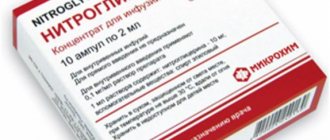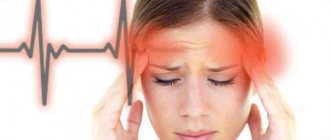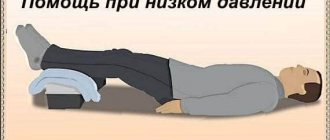Clinical symptoms
Angina pectoris is most often diagnosed in older people; in patients over 65 years of age, symptoms of the disease occur in 20% of cases. The disease is caused by coronary insufficiency of blood supply against the background of myocardial ischemia. The most common cause of angina is atherosclerosis of the arteries; less commonly, pathology can occur after viral or infectious diseases.
A distinction is made between angina at rest, which occurs at night, and angina pectoris caused by psycho-emotional or physical stress. A pronounced symptom of the disease is chest pain. They have a pressing, squeezing, burning or cutting character. The intensity can be tolerable or very strong, causing patients to moan, scream, and feel the fear of approaching death. A person puts his hand to his chest, tries to move less, and take a comfortable position.
The pain radiates mainly to the left shoulder blade, neck and epigastric region, which can cause nausea, heartburn, and colic. With an atypical attack of angina, discomfort spreads to the right half of the body and lower limbs. In rare cases, pain is localized only in the epigastrium or head, which makes diagnosis much more difficult.
Additionally, a person is concerned about the following symptoms:
- pale skin;
- lack of air;
- cold, clammy sweat;
- chilliness, numbness of the hands;
- high blood pressure;
- arrhythmia;
- extrasystole.
Malaise can be caused by climbing stairs, overeating, stress, prolonged exposure to wind and cold air, and high blood pressure. In such situations, the heart experiences oxygen starvation, since a sufficient amount of blood does not flow through the narrowed, thrombosed arteries. If a patient develops hypertrophy of the walls of the left ventricle, a lack of oxygen is also observed during physical activity, even in the absence of coronary stenosis.
At first, the pulse and heartbeat increase, then these indicators return to normal, possibly causing an irregular heartbeat. An attack of angina pectoris lasts up to 20 minutes; after taking Nitroglycerin, sitting or lying down, the pain goes away within 2–3 minutes.
Symptoms of angina
A characteristic symptom of angina is severe squeezing pain in the chest, radiating to the left arm, shoulder, neck or jaw. The attack lasts from a few seconds to 10-15 minutes, and stops at rest or after using medications. In some cases, the disease may manifest itself as headache or toothache, shortness of breath and pulse irregularities - it becomes too frequent or, conversely, slow, and sometimes arrhythmia develops. The patient's skin becomes covered with cold sweat, becomes pale, and he develops a strong feeling of fear.
Symptoms of the disease in women and men most often differ from each other. Representatives of the fair sex complain of pain in the abdominal region, dyspeptic disorders (nausea, vomiting), and in male patients attacks of angina are accompanied by shortness of breath.
Angina occurs in two forms - stable and unstable. The stable form, which is also known as angina pectoris, develops after meals, physical or psycho-emotional stress. The attack usually goes away after the factor that caused it is eliminated. The unstable form of the disease develops in a calm state - most often during night sleep.
Advice: lying down makes the symptoms of angina worse, so to eliminate the discomfort you need to take the appropriate medicine, then sit down and try to relax.
The course of angina in hypertensive patients
Arterial hypertension is one of the risk factors for coronary heart disease and stroke. Particularly common is the combination of various forms of cardiac pathology (angina, stroke, arrhythmia, heart attack) with a systematic increase in pressure. The complex of abnormalities may increase the risk of cardiovascular complications and death.
Long-term hypertension and angina pectoris cause changes in cardiac tissue, left ventricular hypertrophy develops, characterized by thickening of the walls. This leads to disruption of the function of this department, the ventricular cavity expands, and symptoms of heart failure occur. Signs of angina pectoris are observed against the background of an increase in myocardial mass.
What is angina
When there is poor oxygen supply to the heart muscle, a person develops ischemic heart disease, or coronary heart disease. It can be acute (myocardial infarction) or protracted and paroxysmal - in such cases it is customary to talk about angina. The reasons for the development of pathology include:
- atherosclerosis (narrowing of the lumen of the arteries by more than 75%);
- arterial hypertension;
- excess weight, excess cholesterol in the body;
- hereditary factors (disorders of the cardiovascular system in close relatives);
- pathologies and damage to the coronary vessels, congenital or acquired;
- smoking, unhealthy lifestyle, physical inactivity;
- thrombosis and dysfunction of the cardiovascular system;
- hormonal imbalance, abuse of oral contraceptives;
- diabetes;
- syphilis.
Advice: in 95-98% of cases, coronary heart disease develops as a result of atherosclerosis, therefore, to prevent ischemic heart disease and its symptoms, special attention should be paid to its prevention.
Diagnosis of the disease
To confirm the diagnosis, an ECG and daily ECG monitoring are done. The examination allows you to record attacks of angina pectoris. EchoCG is necessary to assess the condition of the myocardium and localize areas of ischemia. Scintigraphy is indicated to identify foci of necrosis, coronography is performed to determine the extent of arterial damage. Velgoergometry is a test that determines the maximum load that a patient can withstand without the threat of ischemia.
Laboratory diagnostics include analysis of the level of total cholesterol, HDL, LDL, triglycerides, glucose, and electrolytes. Determining the concentration of T-markers and cardiac troponins is necessary to assess the condition of the heart muscle - an increase in their level indicates a previous heart attack or post-infarction angina.
Angina at rest
It literally arises out of nowhere, without obvious provoking factors. The attack begins in conditions of physical rest, is characterized by duration and severe pain, lack of air, and heart rhythm disturbances. To relieve attacks, complex drug therapy is prescribed. Typically, resting angina occurs with severe, multiple arterial damage. It is dangerous, and often with its symptoms, coronary artery bypass grafting is indicated to create alternative pathways for coronary blood flow. Often, after a few years, the operation must be repeated, since resting angina tends to renew symptoms.
Regardless of stress or rest, sudden chest pain is a consequence of spasm of the vessels that are responsible for supplying blood to the heart muscle. The spasm does not give the heart enough oxygen. Unlike acute myocardial infarction, after which the heart muscle or its fragment cannot be restored, with angina pectoris the disorder of coronary circulation is not permanent.
Medicines for angina pectoris and high blood pressure
When drawing up a treatment regimen, the cardiologist takes into account not only the mechanisms of development of coronary artery disease, but also the causes of hypertension. Therapy is aimed at reducing the likelihood of complications and mortality, since hypertensive patients are at increased risk, which is directly proportional to the degree of increase in blood pressure (diastolic indicators are important).
When prescribing therapy, existing systemic diseases, age, left ventricular hypertrophy, and the presence of metabolic disorders are taken into account. At the same time, hypertension and angina pectoris are treated, patients are prescribed combination drugs that lower blood pressure. It is necessary to reduce the pressure gradually; if the tonometer readings drop sharply, a heart attack may occur due to a decrease in blood flow to the heart.
For angina pectoris with high blood pressure, β-blockers are prescribed. The drugs reduce heart rate, lower blood pressure, and increase oxygen delivery to the heart. For high blood pressure, preference is given to selective (Atenolol, Bisoprolol) and β-blockers with vasodilating properties (Carvedilol, Nebilet). Long-acting antihypertensive tablets allow you to control blood pressure fluctuations throughout the day.
Hypertension and angina are treated with calcium antagonists. These are first-line drugs that are especially effective for concomitant atherosclerosis, tachycardia, and in patients over 65 years of age. Medicines affect the smooth muscles of vascular walls, promote the release of nitrogen from the endothelium, reduce platelet activity, the level of harmful cholesterol in the blood, and prevent the proliferation of lipid plaques.
For the treatment of angina and high blood pressure, patients are prescribed Plendil, Cardil, Verapamil. These are calcium antagonists with a slow release of active substances, which ensure the maintenance of a constant concentration of the drug in the blood.
Statins are prescribed for high cholesterol and triglyceride levels. The medications prevent the formation of atherosclerotic plaques; when taken, the risk of blockage of the coronary arteries and myocardial infarction is reduced.
Nitrates relieve spasms and increase the lumen of blood vessels. This group includes Nitroglycerin, which is taken during an attack of angina. Under its influence, blood pressure decreases, myocardial oxygen demand decreases, and peripheral vascular resistance decreases. The drugs restore blood circulation in the small vessels of the heart and relieve pain.
If a patient is diagnosed with left ventricular hypertrophy, mitral regurgitation, heart failure, pulmonary hypertension, retardated forms of Nitrosobit are prescribed.
Low pressure
Hypotension with angina is rare. The pathology is accompanied by the following manifestations:
- discomfort behind the sternum;
- decreased muscle tone;
- weakness, decreased performance, indifference to the outside world;
- tinnitus, headaches;
- disturbances in the depth and frequency of breathing.
Pain with hypotension varies and does not depend on the emotional state or physical activity of the patient.
Attention! Sublingual nitroglycerin during attacks of pathology manifested by low blood pressure increases the severity of symptoms and therefore cannot be used.
Treatment
In case of angina pectoris, hypotension therapy is carried out comprehensively. Patients are prescribed plant-based sedatives (valerian, motherwort), natural preparations that increase the tone of the body.
See also Stage 3 hypertension
If therapy does not bring results, it is recommended:
- caffeine-based drugs that relieve pain;
- Tonginal, which normalizes blood pressure and improves metabolic processes in myocardial tissue.
In consultation with the doctor, traditional medicine can also be used.
Attention! Normalization of blood pressure and pulse during angina pectoris accompanied by hypotension is facilitated by placing a pinch of salt under the tongue. But this method should not be used too often: it can cause deterioration in kidney function.
Angina with low blood pressure
In some cases, the cause of angina is low blood pressure. The patient's blood flow to the mouths of the coronary arteries and cardiac output decrease, and the myocardium experiences oxygen starvation. A decrease in blood pressure can be caused by taking medications, tachyarrhythmia, or venous hypotension.
If your blood pressure is low, you should not take Nitroglycerin during an attack; drugs from the nitrate group will further lower blood pressure, which can lead to myocardial necrosis. To relieve pain, it is recommended to take a horizontal position to ensure blood flow to the heart and brain.
A sharp drop in blood pressure can be a symptom of a heart attack, so you must urgently call an ambulance, apply a warm compress to your feet or put woolen socks on the patient.
Prevention of angina
Risk factors
Who is at risk of developing angina? As with any disease, risk factors can be individual and controllable, or they can be objective data. These include:
- age,
- floor,
- heredity.
It has already been noted that men suffer from this disease more often. It's all about hormones. Estrogens protect the heart and blood vessels, and women with good hormonal levels are in a more protected position before the onset of menopause. After 55 years, estrogens cease to perform their protective function, and female angina becomes as common as male angina. Angina pectoris tends to be hereditary, and direct descendants of patients with coronary heart disease or those who have had a heart attack are at risk.
It is difficult to influence these factors, and you need to constantly take care of your health and the condition of the heart muscle. Moreover, there are also modified risk factors for angina that a person can cope with, eliminate from his life, or at least significantly reduce. These include:
- blood cholesterol level,
- obesity,
- diabetes,
- smoking,
- hypertension,
- anemia,
- "thick blood",
- stress and psycho-emotional stress.
Often these risk factors are reduced one by one, simply by following all the known rules of a healthy lifestyle. We lower cholesterol, reduce weight, move more, worry less, and quit smoking. In a word, if there is something that can be fixed, we fix it.
Blood cholesterol level
Hyperlipidemia, or increased cholesterol levels, is present in almost everyone who suffers from angina. Due to the fact that we want to provide nutrition to the myocardium, we do not need cholesterol deposits in the arteries and thrombus formation in the vessels. To do this, you should get involved in adequate physical activity (at least walk 30 minutes a day), keep your waist in shape (at least 95 cm for men and 80 cm for women), eat legumes, stone fruits, sea fish, vegetables and fruits. Fall in love with kefir and cottage cheese, stop loving sweets and buns. Translating into numbers, patients with angina should not consume more than 300 mg of cholesterol per day and 5 g of salt per day
.
Overweight
Another risk factor for angina is obesity. Physical activity will have to be increased. Insufficient physical activity is a good “gateway” to obesity and lipid metabolism disorders. It also makes sense to reduce your intake of “fast” carbohydrate foods in order to avoid the development of diabetes. It doubles the risk of angina.
Smoking
Probably everyone knows about smoking. The connection between the risk of angina pectoris and smoking is very direct. Smoking increases the level of carboxyhemoglobin in the blood. It is a combination of carbon monoxide and hemoglobin. It causes oxygen starvation of cells. Moreover, it is the same cardiomyocytes, the cardiac muscle cells, that suffer first. Smoking causes spasm of the arteries, and the heart muscle begins to urgently need oxygen. The reason for angina pectoris is the most obvious.
In addition, when smoking, anemia and intoxication of the body often develop, and they also reduce the delivery of oxygen to the heart muscle, even in the absence of severe atherosclerosis.
Arterial hypertension
A very common risk factor for angina is arterial hypertension. With moderately elevated pressure, myocardial tension increases, and it needs more and more oxygen. Its deficiency in this case is more obvious than with normal blood pressure.
Violation of blood properties
Another risk factor for angina is a violation of the rheological properties of blood, mainly due to an increase in the concentration of red blood cells, leukocytes and platelets. This is often combined with an increase in blood sugar. This “set” forces cell membranes to be more active, red blood cells and platelets literally “stick together.” This is how blood clots appear. There is an opinion that “thick blood” can become normal thanks to oxygen and proper nutrition. Many fans of traditional medicine take aspirin “for blood clots,” but prescription medications for “self-medication” are not the most straightforward way to maintain health. Therefore, depending on the state of the digestive system, you can introduce foods into your diet that help normalize blood viscosity. These are sour foods (lemon, pomegranate, black currant), beets, nuts, garlic, fatty fish. Our grandmothers said that viburnum, a berry that contains rare vitamins P and K and many valuable minerals, was and remains an invaluable cure for “thick blood.” By the way, it helps to calm down well, and will be a good help in getting rid of the next risk factor - stress.
Stress
Many people like to confidently say that “all diseases come from nerves.” Maybe not all, but heart problems are really closely related to stressors and the ability to cope with them. The mechanism of stress on the heart muscle is as simple as it is dangerous. Fear and stress do not allow you to relieve muscle tension. We know this; everyone has heard the expression “shrinked with fear” more than once or felt muscle spasms during a stressful situation. So, not only muscles contract due to stress, but in the same way, spasms of blood vessels inside our body occur. And here it is difficult to do something, because only getting rid of pathological emotions allows the central nervous system to launch a mechanism that eliminates fixations, allowing the spasm to be relieved. Under stress, the heart also works under conditions of increased load, and vasospasm develops - narrowing of blood vessels, small arteries and capillaries. This disrupts blood circulation and reduces the supply of oxygen to the myocardium.
Surgery
Surgery is performed to increase the lumen of arteries narrowed by atherosclerotic plaque. Treatment is performed in several ways:
- stenting – insertion of a stent (mesh prosthesis) into an artery;
- coronary artery bypass grafting – creating a bypass route for blood flow to the heart;
- laser revascularization - the formation of artificial passages in the myocardium so that blood flows bypassing the coronary arteries; the operation is contraindicated if left ventricular hypertrophy is detected;
- angioplasty - insertion into a vessel of a catheter with a balloon, which increases the lumen of the artery when filled;
- heart transplant.
Surgical intervention is indicated for severe forms of coronary artery disease, acute heart failure, and angina pectoris that cannot be cured with medication.
Main cause of angina
This is a pathological condition in which the blood supply to the myocardium is disrupted due to damage to the coronary arteries. With ischemic disease, the myocardium, in other words, the heart muscle, suffers. She lacks a normal blood supply and her metabolic health is compromised. In case of coronary heart disease, the heart muscle seems to starve, constantly suffering from a lack of oxygen and nutrients. She begins to work hard, from time to time giving painful signals of “hunger”. She needs oxygen. A severe deficiency causes myocardial infarction, the death of part of the heart muscle, and a chronic deficiency causes periodic attacks of angina. The heart muscle consists of cardiomyocytes - the muscle cells of the heart. They, like any cells in the body, constantly need oxygen. But their needs are not met due to vasospasm, there is not enough blood flow, and oxygen supply is impaired. The conduction and transmission of blood does not allow the heart muscle to be filled with substances necessary for a full life and work; its metabolism is disrupted. It's like she can't breathe. This leads to ischemia, damage to the heart muscle.
As a result, metabolic processes in the myocardium are disrupted. For example, excessive accumulation of under-oxidized metabolites (lactic, carbonic, phosphoric acids), ionic balance is disturbed.
All this leads to pain. The myocardium changes, these unpleasant changes are called the “ischemic cascade”, which begins with subtle changes in the flow of blood into the muscle, and reveals itself in angina pectoris - painful symptoms of the heart muscle responding to a lack of oxygen. Angina attacks develop when the lumen of the coronary arteries narrows by 50-70%; the spasm must be confident and strong.
Causes of angina attack
An attack is a very unpleasant, frightening, painful phenomenon. It can occur as a result of tension during physical or emotional stress. Sometimes a simple walk with effort (uphill, with a heavy bag) or a negative emotion after a difficult telephone conversation is enough. Quite often, angina pectoris makes itself felt in a state of complete rest of the body, in sleep. These symptoms became the basis for the classification of angina pectoris adopted by the World Health Organization in 1979 and the All-Union Cardiology Research Center of the USSR Academy of Medical Sciences in 1984.
Prognosis for angina pectoris
The disease has a progressive course and can lead to myocardial infarction, disability and death. Long-term complications include cardiosclerosis and chronic heart failure. High blood pressure during angina pectoris in men and women, left ventricular hypertrophy complicates the course of coronary artery disease and contributes to the progression of the pathology.
With prolonged hypertension in patients, the structure of intracerebral arteries changes - this causes neurological and mental disorders, leading to stroke or dysfunction of cerebral circulation.
Systematic therapy and implementation of preventive measures help improve the prognosis, improve the patient’s quality of life, and help maintain working capacity.
Blood pressure correction
Hypertension with angina pectoris
The main goal of treating angina with high blood pressure is to reduce the risk of death from myocardial infarction, stroke and kidney failure.
Medicines for angina are also used for hypertension. The drugs cannot completely cure coronary heart disease, but they can reduce the frequency of attacks and their intensity to a minimum. Also, when taken correctly (long-term and regularly), they reduce blood pressure to a safe level. This significantly improves the quality and life expectancy, performance and general psychophysical state and emotional background. The person feels less sick.
How is hypertension treated if it is accompanied by angina?
Severe symptoms of hypertension are usually recorded with stable angina. In the absence of adequate medical care, CVS progress and myocardial necrosis develops, leading to death.
The main goal of drug therapy is to keep blood pressure within 140/90 mm Hg. Art. It is important that the decrease occurs gradually and does not provoke a reflex of increased heart rate. For angina pectoris with symptoms of high blood pressure, the following groups of drugs are prescribed:
- Beta blockers. They reduce heart rate, lower blood pressure, and increase myocardial endurance.
- Nitrates. They help relax the walls of blood vessels, reduce the volume of blood passing through the heart, and reduce oxygen consumption by the myocardium.
- ACE inhibitors. They dilate blood vessels, prevent the appearance of blood clots and the proliferation of cellular tissue, and reduce the likelihood of left ventricular hypertrophy.
- Calcium antagonists. They help dilate arteries and the vascular network: blood pressure decreases and, accordingly, the load on the heart.
- Antiplatelet agents. They stop inflammation, eliminate blood clots and pathological growths of cellular tissue.
Diagnosis of angina pectoris
To diagnose angina pectoris, as well as exclude other possible diseases, complaints and the nature of pain are analyzed, laboratory blood tests and a functional examination of the heart are performed, and the patient’s physical condition is analyzed.
It is also important to determine the severity and severity of the process. To do this, if a diagnosis of acute coronary syndrome is made, a study of the vascular bed of the heart is performed - coronary angiography. Based on the results, the question of surgery or intravascular intervention is decided.
Laboratory blood diagnostics help determine the level of:
- total cholesterol and lipid fractions,
- high and low density lipoproteins,
- triglycerides,
- creatine kinase,
- glucose,
- markers of systemic inflammation (SII),
- indicators of the coagulation system - coagulograms,
- electrolytes,
- troponin - in acute situations.
Particular attention in the study is paid to the presence of cardiac troponins I and T - markers that indicate myocardial damage. Their presence confirms that the patient is suffering a microinfarction or acute myocardial infarction.
Functional research methods allow you to determine the condition of the heart:
- ECG - examination at the peak of an angina attack determines conduction and rhythm disturbances. Signs of myocardial oxygen starvation may also be detected.
- Daily ECG monitoring - records the level of oxygen starvation during an attack of angina, heart rate, arrhythmia. Indicators help determine the specific diagnosis and stage of the disease.
- EchoCG - reveals local ischemic changes and disorders of myocardial contractility.
- Bicycle ergometry or treadmill - determines the maximum possible physical activity for the patient without the threat of developing ischemia. The load is set using an exercise bike or treadmill, and the results are recorded by an ECG device.
- Stress echocardiography (Stress-ECHO) is a study of myocardial contractility using the ultrasound method, under conditions of dosed physical activity. At the same time, an ECG is recorded. Allows you to make a primary diagnosis of IHD and clarify indications for surgical treatment.
For a detailed study of the vascular bed of the heart, the following are used:
- Coronary angiography is an X-ray method in which a contrast agent is injected into the arteries of the heart using a special catheter.
- multislice computed tomography is a type of computed tomography in which X-ray “slices” of the heart and blood vessels are obtained at high speed. More than 100 such “slices” can be performed between contractions of the heart chambers.
These studies allow us to obtain information about the state of the vascular bed of the heart: which arteries are passable, which are completely or partially blocked, and in what place. Based on the information received, the doctor makes a decision about whether the patient has coronary artery disease, the need for surgical intervention and the timing of treatment.
High blood pressure
Arterial hypertension and angina pectoris are cardiovascular diseases that are closely related to each other. Therefore, it is impossible to find out what is the cause and what is the effect. Hypertensive patients suffering from the disease for two to three years often experience attacks of angina pectoris. An increase in blood pressure against the background of progression of pathology is a factor complicating the course of the disease.
- causes deterioration of blood flow, increased wear and tear of the heart and cardiovascular system;
- increases the risk of developing myocardial infarction and chronic heart failure;
- changes the structure of the left ventricle, leading to its hypertrophy.
Treatment
As a rule, an intense increase in pressure during angina pectoris is diagnosed in the presence of a stable form of the disease. The pathology is dangerous to human health due to the fact that it entails deterioration of the condition, the development of myocardial necrosis, and death.
The main goal of treatment in this case is to maintain blood pressure at 140/90, and it should decrease gradually. This will avoid a reflex increase in heart rate.
Patients are prescribed the following medications:
- nitrates, which reduce the volume of blood passing through the heart and the organ’s need for oxygen;
- calcium channel blockers, dilating arteries and blood vessels, lowering blood pressure, reducing cardiac workload;
- beta blockers, which reduce the heart rate, lower blood pressure, and increase the susceptibility of the myocardium to increased stress;
- antiplatelet agents that relieve inflammation, prevent the formation of blood clots, and increased cell proliferation;
- ACE inhibitors, dilating blood vessels, preventing cell proliferation.
Unstable angina leads to increased blood pressure much less frequently.
Attention! The doctor must select a treatment regimen for stable and unstable angina, including the treatment of exertional angina, and its duration. Self-medication is unacceptable, since it can significantly worsen the general condition of patients, aggravating the course of the disease.
Traditional medicine for the treatment of blood pressure due to angina pectoris in women and men is used only after the approval of a cardiologist and exclusively as an additional therapy. Patients are recommended to consume foods that strengthen vascular walls and reduce the risk of atherosclerosis. During attacks of angina pectoris, it is advisable to take hawthorn or valerian infusion, and to reduce their frequency - decoctions of hawthorn and mountain arnica.
Attention! Before you begin treating hypertension with angina pectoris in men and women, you need to remove the factors that provoke the development of these pathologies: excess weight, bad habits, poor diet, lack of physical activity.
Why is angina pectoris dangerous?
Angina pectoris reduces a person’s quality of life – it is difficult for him to climb stairs, carry even minor loads and cope with stress. A prolonged attack of the disease (more than 15 minutes) requires medical attention, since due to constant hypoxia of the heart muscle, patients are at risk of developing myocardial infarction. The progression of the pathology can lead to disability and serious health complications - cardiosclerosis or CHF (chronic heart failure).
Further treatment of angina pectoris
The patient must remember that the lack of constant and adequate treatment for angina pectoris can lead to the progression of coronary artery disease and its complications. Treatment of angina should be comprehensive and aimed at preventing attacks and complications of this disease.
The treatment plan includes:
- diet;
- rejection of bad habits;
- combating obesity;
- sufficient physical activity;
- exclusion of stressful situations;
- drug treatment;
- surgical treatment (if indicated).
Diet
Patients with coronary artery disease are recommended to follow diet No. 10C. The general rules of rational nutrition for this disease must be observed by the patient throughout his life:
- Correspondence of the total caloric content of the diet in relation to the energy consumption and physical activity of the patient. As a rule, physical activity in patients with angina is reduced and they should reduce the caloric content of their usual diet.
- Significant limitation of the use of table salt (see “How much salt does a man need”).
- Avoid taking foods that have a stimulating and stimulating effect on the nervous system, heart and blood vessels.
- A significant reduction in the consumption of foods containing cholesterol, easily digestible carbohydrates and animal fats. The degree to which you reduce your consumption of such foods should depend on your body weight.
- Increasing the proportion of fish and vegetable proteins in relation to animal proteins contained in meat and poultry.
- Introducing into the diet a sufficient amount of foods rich in vitamins B, E, PP, P and C, lipotropic substances (lecithin, choline, methionine), dietary fiber, fatty acids, potassium, magnesium, chromium, zinc and some other trace elements.
- Achieving and maintaining normal body weight.
Compliance with diet No. 10C is aimed at:
- prevention of progression of atherosclerosis of coronary vessels, brain vessels and other organs;
- prevention of progression of coronary artery disease and hypertension caused by atherosclerosis;
- obesity prevention.
If you have IHD, you should limit your consumption of foods such as:
- fatty meats (pork, lamb, fatty beef, geese, ducks, offal and lard);
- fatty dairy products;
- meat broths;
- hard fatty cheeses;
- egg yolks;
- butter, margarine, mayonnaise;
- smoked meats;
- caviar;
- mushrooms;
- sausages;
- butter dough and confectionery products;
- pasta;
- chocolate;
- strong tea, coffee and cocoa.
Dishes should be prepared without salt by boiling, steaming, stewing or baking. Salt should be added to dishes (up to 5-6 g per day). Meals should be taken 4-5 times a day in small portions, and dinner should take place 3-4 hours before bedtime.
It is recommended to include in the diet:
- grain products and cereals (limit rice and semolina to a minimum);
- vegetables, unsweetened fruits, berries and dried fruits;
- fresh juices without added sugar;
- low-fat dairy products (instead of butter, it is better to add sour cream or cream to dishes);
- egg yolks (in the absence of contraindications, no more than 3 pieces per week);
- refined vegetable oils (olive, flaxseed, corn, sunflower);
- rye bread or bread made from grade II wheat flour (no more than 150 g per day);
- vegetable salads and vinaigrettes with vegetable oil;
- first courses with low-fat broth (no more than once a week), vegetable, milk and fruit soups;
- main courses of lean fish, meat and poultry;
- seafood;
- low-fat soaked herring (no more than 1 time per week);
- steam egg white omelette;
- drinks (weak tea, rosehip infusion, compotes, jellies, fruit drinks and mousses).
Drug therapy
To treat angina, medications are used that help dilate blood vessels and improve blood supply to the myocardium. The tactics of drug therapy are determined individually depending on the clinical case.
Table 1 - Medicines used for drug therapy of angina pectoris.
| GROUP OF MEDICINES | PURPOSE OF USE |
| Nitro-containing drugs | To relieve heart pain |
| Calcium channel blockers | To dilate coronary vessels |
| Antiplatelet agents | To reduce blood viscosity and prevent blood clots |
| ACE inhibitors | Used in the presence of hypertension |
| β-blockers | Used in the presence of tachycardia |
| Lipid-lowering drugs | Used for hypercholesterolemia |
| Cardiometabolic agents | To improve myocardial contractile functions and reduce the number of attacks |
Drug therapy for angina pectoris can be supplemented by treatment of concomitant diseases and therapeutic physical exercise. Patients are recommended to regularly monitor their blood pressure and undergo clinical follow-up with a cardiologist.
Medicines with proven effectiveness in treatment
| Acetylsalicylic acid | This is regular aspirin in a dosage of 75-100 mg. The trade name often includes the prefix "cardio". Resists thrombosis. |
| Beta blocker | Blocks the effect of adrenaline on receptors. Reduces the heart's need for oxygen during exercise, which has a positive effect in the treatment of angina pectoris. Lowers systolic and diastolic blood pressure. |
| ACE inhibitors | Suitable for those who have diabetes, preventing the development of nephropathy. Reduce left ventricular hypertrophy. |
| Nitroglycerine | Nitric oxide, which is released from the drug in the vascular wall, dilates the coronary arteries during myocardial ischemia, thereby restoring blood circulation in the muscle area. |
| Calcium antagonists | Prescribed when beta blockers are contraindicated (heart failure, blockade of the conduction system, bronchial asthma) |
| Lipid-lowering therapy | Statins, fibrates and bile acid sequestrants - drugs that normalize cholesterol and lipoprotein levels |
You should not completely rely on medications, because without changing your lifestyle, they partially lose their effectiveness.
Hypotension with angina pectoris
Until recently, it was believed that low blood pressure was better than high blood pressure. However, the statistical analysis suggests that systolic blood pressure 110 and below, and diastolic blood pressure 60 and below are no less a risk factor for the development of myocardial infarction than hypertension.
Hypotension is characteristic of women of reproductive age, as well as patients with severe atherosclerosis. Low blood pressure occurs in patients who mistakenly take high doses of antihypertensive drugs.
As a rule, a person feels that the pressure is low - dizziness, staggering, and fatigue appear. Yes, at the moment the optimal method for correcting this condition is normal physical activity, consuming caffeine-containing products in moderation and wearing compression stockings.
Treatment of angina attacks with hypotension appears to be a difficult task, since most drugs prescribed for this disease exhibit a blood pressure-lowering effect.
Video on the topic
About the types, symptoms and methods of treating angina in the video:
As you can understand from this article, the symptoms of angina can be eliminated only if the cause of the ailment has been clarified. Only then will the doctor select the optimal treatment based on the symptoms. During therapy, it is important to adhere to all recommendations of specialists.
The information on the MyMedNews.ru website is for reference and general information, collected from publicly available sources and cannot serve as a basis for making a decision on the use of medications in the course of treatment.
MyMedNews.ru
And we also have
Blood pressure is 110 over 70 - what does this mean and is it worth doing something?










